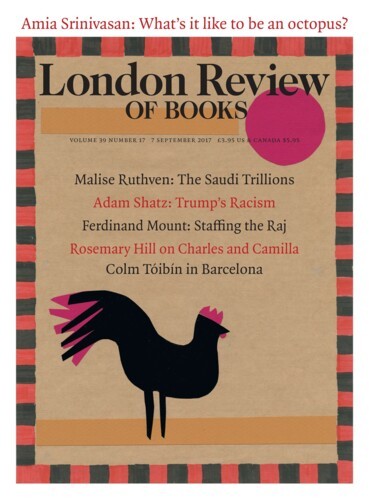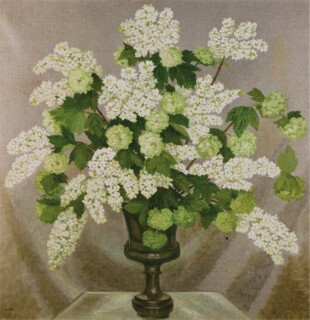On 28 April 1870, Miss Stella Boulton and Mrs Fanny Graham attended the Strand Theatre in London, where they made a spectacle of themselves, catcalling from their box to various men below. As the giddy pair left and approached their carriage, a plain-clothes detective stopped them: ‘I have every reason to believe that you are men in female attire.’ Stella was indeed one Ernest Boulton, music hall artiste and rent boy, and Fanny was Frederick Park, a trainee solicitor. At Bow Street police station they were arrested and charged with sodomy. Stella, it transpired, had been living as the wife of Lord Arthur Pelham-Clinton MP, who promptly died of cholera before the case went to trial. In Westminster Hall, before the Lord Chief Justice, a jury acquitted Fanny and Stella: there was no evidence of buggery, and nobody could determine that cross-dressing was a crime.
There are two studio photographs of ‘The Funny He-She Ladies’, as the newspapers called them, in the Tate’s survey of a century and slightly more of queer British art, from 1861 to 1967, the year male homosexuality was decriminalised (the show closes on 1 October). Here is Lord Arthur doted on by curl-headed Ernest and Fred, who are in masculine mufti, and then crinolined Fanny and Stella à deux: all over each other like sentimental sisters. It was just nine years since the death penalty for the crime of sodomy had been abolished in England and Wales, and 25 years before Oscar Wilde’s trial. (The exhibition includes Wilde’s cell door from Reading Gaol.) As Neil McKenna points out in his catalogue essay, Boulton and Park would almost certainly have called their evening get-up ‘drag’; but they would not yet have thought of themselves as ‘queer’ or ‘homosexual’: terms not established till the 1890s. Queer British Art begins at a moment when its theme is both overdetermined – the insistence on anal sex as evidence – and ambiguous, frequently unnoticed or elided.
Consider the range of male artists and male bodies that opens the exhibition. When Simeon Solomon’s painting Bacchus – doe eyes, ringlets, Cupid’s-bow lips parted – was exhibited at the Royal Academy in the summer of 1867, it caused no critical stir. But a year later, at the Dudley Gallery, Solomon’s watercolour of the same subject was thought by the Art Journal to depict ‘a sentimentalist of rather weak constitution’. Such euphemism was common enough, but critical reaction sometimes more direct: in 1869, the Times noted that Frederic Leighton’s smooth and golden Icarus, who is billowed about by luscious drapery, also seemed to be showing ‘the soft rounded contour of a feminine breast’. The ‘subtler threads of temperament’ that Walter Pater had adduced in Winckelmann’s Hellenism were more than hinted at in works like Walter Crane’s The Renaissance of Venus (1877), where the goddess is in most physical respects, as writer and artist W. Graham Robertson put it, ‘a fine, upstanding slip of a boy’.
There are considerably fewer female artists, and women’s bodies, in this show than there are men – a fact the Tate curators acknowledge, along with the infrequency of non-white faces: ‘We have been constantly frustrated by the comparative scarcity of material.’ In a section somewhat dutifully titled ‘Defying Convention’, we find John Singer Sargent’s 1881 portrait of an austerely boyish Vernon Lee, and Alvaro Guevara’s Dame Edith Sitwell from 1916. Laura Knight, three years earlier, had been condemned by the Telegraph for a self-portrait with a nude model that lacked ‘the higher charm of the “eternal feminine”’. A few such notable nudes aside, there is a tendency to allegorise lesbian desire in objects and interiors: as in Ethel Sands’s The Chintz Couch of 1911, or the frothy Lilac and Guelder Rose by Gluck (born Hannah Gluckstein) from 1937. Even Claude Cahun – who here counts as British for having lived on Jersey – is represented not by her shaven-headed self-portraits but by photographs of her delicately Surrealist sculptural assemblages under glass bell-jars.
Such displacements, whether on the part of curators or artists themselves, might seem timid, but they have the fortunate effect of posing the question, more frankly than the Victorian male nudes, what a queer aesthetic might look like, as distinct from mere subject matter. The answers are in some ways predictable: there is a room at Tate Britain given over to theatre, in which one may view Noël Coward’s monogrammed scarlet dressing gown and Oliver Messel’s designs for the 1959 film of Suddenly Last Summer. Style, poise, extravagance: these we might expect. (Consider Glyn Philpot’s 1935 painting of Glen Byam Shaw, who is playing Laertes but looks as though he’s stepped off the set of a New Romantic music video fifty years later.) But it’s a certain texture that seems to signify most, as for example in the theatrical photographs of Angus McBean, who was jailed during the Second World War for his homosexuality. McBean’s 1937 portrait of Beatrix Lehmann twins the actress’s face with incongruous block and tackle, and frames this ‘surrealised’ arrangement with silk drapery. His 1941 study of Quentin Crisp is an astonishing instance of the retoucher’s art, the subject’s burnished flesh so perfect it is hardly there at all.
Is it armour or invitation, this confected gleam that connects the queer and the modern? It’s everywhere in Cecil Beaton’s portraits of the late 1920s and early 1930s. Thanks to darkroom dodging and burning, Sylvia Townsend Warner seems to glow with a pure white flame in a photograph from 1930; the Tate catalogue tells us the backdrop is satin, but it looks like Cellophane, which more than any other material meant modernity in this period. The Vogue journalist Madge Garland – she was sacked by Condé Nast for her relationship with the editor, Dorothy Todd – is made to shine with the same sci-fi glamour Beaton gave to the layabout dandy Stephen Tennant in his famous silver-and-leather portrait of 1927. In the same year, Beaton photographed Tennant dressed in pearls and white silk as a sleeping Prince Charming awaiting a kiss. (The catalogue tells us the picture ‘invites interpretation as a study in gender non-conformity’, but ‘invites’ is putting it mildly.) None of this exactly amounts to a camp aesthetic, though that is certainly present (McBean later photographed Danny La Rue), or cliché regarding style and surface. It’s rather a question of queer as a kind of futurism: an attitude or tendency that connects mid-20th-century performers and photographers to contemporary digital art and fashion.
The rest of the exhibition tells a series of doggedly historicist tales about such undeniably vexed and vital scenes as the Soho of the 1940s and the ways a gay underground touched the mainstream in the years before decriminalisation. There are some expected if minor Hockneys and Bacons, but also Edward Burra’s carnival-masked Soldiers at Rye of 1941, Lewis Morley’s 1965 photograph of Joe Orton in Christine Keeler pose, and Orton and Kenneth Halliwell’s scurrilously rectified library books, for which they went to jail. By the end of the show – stills from Basil Dearden’s film Victim (1961), pages from postwar physique mags – the legislative terminus starts to feel historically justified but artistically frustrating. You can imagine a Queer British Art for which 1967 is a pivot towards Derek Jarman, Gilbert and George, Aids activism and beyond, or that dared to ditch even that narrative for more electric affinities between queer modernity and today.
Send Letters To:
The Editor
London Review of Books,
28 Little Russell Street
London, WC1A 2HN
letters@lrb.co.uk
Please include name, address, and a telephone number.


